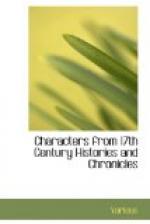As a class, the statesmen and politicians more than hold their own with the other character writers of the seventeenth century. Shaftesbury’s picture of Henry Hastings, a country gentleman of the old school, who carried well into the Stuart period the habits and life of Tudor times, shows a side of his varied accomplishments which has not won the general recognition that it deserves. It is a sketch exactly in the style of the eighteenth century essayists. It makes us regret that the fragmentary autobiography in which it is found did not come down to a time when it could have included sketches of his famous contemporaries. The literary skill of his grandson, the author of the Characteristicks, was evidently inherited.
Sir Philip Warwick has the misfortune to be overshadowed by Clarendon. As secretary to Charles I in the year before his execution, and as a minor government official under Charles II, he was well acquainted with men and affairs. Burnet describes him as ’an honest but a weak man’, and adds that ’though he pretended to wit and politics, he was not cut out for that, and least of all for writing of history’. He could at least write characters. They do not bear the impress of a strong personality, but they have the fairmindedness and the calm outlook that spring from a gentle and unassertive nature. His Cromwell and his Laud are alike greatly to his credit; and the private view that he gives us of Charles has unmistakable value. His Memoires remained in manuscript till 1701, the year before the publication of Clarendon’s History. It was the first book to appear with notable characters of the men of the Civil Wars and the Protectorate.
The Histories and Memoirs of the seventeenth century contain by far the greatest number of its characters; but they are to be found also in scattered Lives, and in the collections of material that mark the rise of modern English biography. There are disappointingly few by Fuller. In his Worthies of England he is mainly concerned with the facts of a man’s life, and though, in his own word, he fleshes the bare skeleton of time, place, and person with pleasant passages, and interlaces many delightful stories by way of illustrations, and everywhere holds us by the quaint turns of his fertile fancy, yet the scheme of the book did not involve the depicting of character, nor did it allow him to deal with many contemporaries whom he had known. In the present volume it has therefore been found best to represent him by the studies of Bacon and Laud in his Church-History. Bacon he must have described largely from hearsay, but what he says of Laud is an admirable specimen of his manner, and leaves us wishing that he had devoted himself in larger measure to the worthies of his own time.




